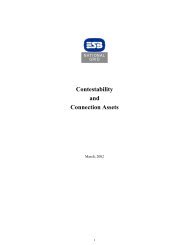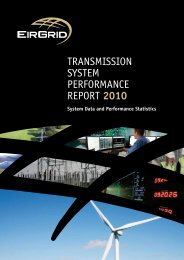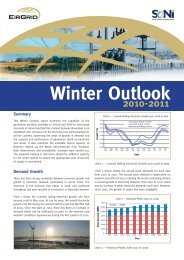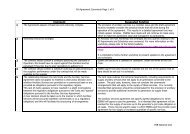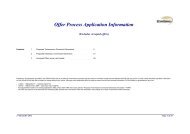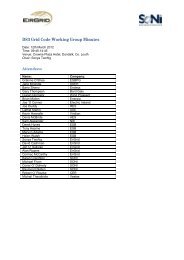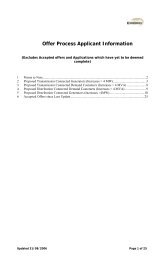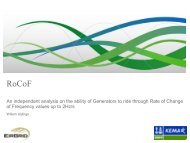Post Operational Readiness Confirmation Post Operations ... - Eirgrid
Post Operational Readiness Confirmation Post Operations ... - Eirgrid
Post Operational Readiness Confirmation Post Operations ... - Eirgrid
Create successful ePaper yourself
Turn your PDF publications into a flip-book with our unique Google optimized e-Paper software.
<strong>Post</strong> <strong>Operational</strong> <strong>Readiness</strong><br />
<strong>Confirmation</strong><br />
i<br />
<strong>Post</strong> <strong>Operations</strong> Certificate<br />
19 th November 2012<br />
Dave Carroll<br />
<strong>Operational</strong> Services and Performance<br />
EirGrid
Overview<br />
Process<br />
Pre-Requisites<br />
1. Performance Monitoring<br />
– Context<br />
– Daily Process<br />
– Monthly Process<br />
– Examples of compliance<br />
1. <strong>Post</strong> <strong>Operational</strong> <strong>Readiness</strong><br />
<strong>Confirmation</strong><br />
i.e. Controllability<br />
2. Ancillary Services 2. <strong>Post</strong> <strong>Operations</strong> Certificate<br />
– Reactive Power<br />
Agreements<br />
3. Derogations<br />
– Process<br />
i.e. Grid Code Compliance<br />
3. <strong>Post</strong> <strong>Operational</strong> <strong>Readiness</strong><br />
<strong>Confirmation</strong>/<strong>Post</strong> <strong>Operations</strong><br />
Certificate<br />
2
Context and Challenges<br />
1. Monitoring and Investigation in Grid Code<br />
– Information Exchange OC 7<br />
– Enforcement of OC10 of the Grid Code<br />
2. Changing plant portfolio to meet demand<br />
– Variable generation i.e. wind increasing year on year<br />
3. Complex Outage Planning Process<br />
– Aligning generator outage with transmission outage is proving difficult<br />
4. Management of Constraints Costs<br />
– TSO incentivised to minimise these costs, effective TY 2012-2013<br />
3
EirGrid Roles and Responsibilities<br />
1. Real-Time Operation (NCC)<br />
– Provides running orders and issues dispatch instructions<br />
– Balances the system in real-time to meet demand and reserve requirement<br />
2. Performance Monitoring i (OSP)<br />
– Reviews the performance of all units connected to the system and follows<br />
up on non-compliant units; (PM team)<br />
– Carries out Dispatch Testing/Grid Code Testing (C&T team)<br />
– Assesses trends in unit performance and requests information where a<br />
trend is significant to determine whether testing/derogation g required;<br />
– Carries out studies and detailed investigation is carried out where<br />
necessary<br />
3. EMS Support<br />
– Investigate RTU/telemetry issues<br />
4
WFPS Performance Monitoring Process<br />
1. Daily monitoring (TD + 1WD) and follow up:<br />
• Available Active Power<br />
• Failure to follow Active Power setpoints and voltage setpoints<br />
• Signal issues (e.g. MW setpoint feedback)<br />
• Fault Ride Through<br />
2. Monthly Reports to monitor consistent non-compliance:<br />
• Dispatch Instructions<br />
• Available Active Power<br />
3. Studies & Investigations where appropriate<br />
• Protection Standards<br />
4. Monetary incentives/charges<br />
• To be raised as part of OSC consultation for TY 2013-2014<br />
5
WFPS PM Events ‐ 1 st March 2011 to 13 th August 2012:<br />
Performance Parameter<br />
Trip<br />
Non-Compliance with Dispatch Instruction<br />
Signal Issue<br />
Fault Ride Through<br />
No of Events<br />
15<br />
129<br />
83<br />
45
1. Performance Monitoring (PM) – Daily<br />
Process
Daily PM – What is monitored<br />
‣Dispatch Instructions<br />
•Required to control system<br />
frequency<br />
• To control power flows /<br />
contingencies on system<br />
•SEM Settlement and<br />
Constraint Payments<br />
(VPTGs)<br />
‣Availability<br />
• Required for<br />
Constraints/Curtailment in<br />
Wind Dispatch Tool<br />
• Required for Availability<br />
Reporting<br />
• SEM Settlement and<br />
Capacity Payments
Performance Monitoring – Examples<br />
1. Dispatch Instruction Non-Compliance<br />
2. Available Active Power Issue<br />
3. Fault Ride Through<br />
9
1. Dispatch Instruction Issue
2. Available Active Power Issue
3. Fault Ride Through
Daily PM and Controllability<br />
1. Category (i) WFPS<br />
– Not controllable and requires dispatch test which is carried out by C&T team<br />
2. Category (ii) WFPS<br />
– Daily monitoring of all Category (ii) WFPS carried out through PM team<br />
– All have received <strong>Operational</strong> <strong>Readiness</strong> <strong>Confirmation</strong><br />
– Purpose is to ensure ‘Controllable’ WFPS maintain compliance<br />
– All Category (ii) WFPS have 12 months / until 1 st December 2013 from receipt of <strong>Operational</strong><br />
<strong>Readiness</strong> <strong>Confirmation</strong> to obtain <strong>Operations</strong> Certificate (full Grid Code Compliance)<br />
3. Category (iii) WFPS<br />
– Commissioning unit which must achieve successful dispatch test for <strong>Operational</strong> <strong>Readiness</strong><br />
<strong>Confirmation</strong><br />
– Legacy units have until 1 st December 2012 to move to Category (ii) or otherwise be moved to<br />
Category (i)
Daily Non-Compliances for Category<br />
(ii) WFPS<br />
From 1 st February 2013 all Category (ii) will be<br />
assessed on a daily basis for the following:<br />
1. Dispatch Instructions (DIs)<br />
– Failure to accurately follow instruction by wind dispatch tool<br />
2. Available Active Power (AAP)<br />
– Signal is stuck on a particular value/zero/freezes<br />
‣ Where non-compliance is found IPP is given 10WDs<br />
to resolve/rectify the issue otherwise be moved to<br />
Category (i)
Daily DI Non-Compliance Process<br />
What<br />
1. DI non‐compliance identified & telemetry ruled<br />
out<br />
Who<br />
PM Team<br />
2. Email the IPP stating 10WDs to rectify PM team<br />
3. Arrange dispatch test following end of 10WD C&T team<br />
4. Obtain test results/report and email IPP of<br />
•Category (ii) unchanged if successful<br />
•Move to Category (i) if unsuccessful<br />
PM team<br />
5. If unsuccessful WFPS moves to Category (i) C&T team<br />
6. Email IPP to confirm category (i) change is<br />
effective and close issue with IPP<br />
PM Team
Daily Availability Non-Compliance Process<br />
What<br />
1. Availability non‐compliance identified &<br />
telemetry ruled out<br />
Who<br />
PM Team<br />
2. Email the IPP stating 10WDs to rectify PM team<br />
3. Arrange dispatch test following end of 10WD C&T team<br />
4. Obtain test results/report and email IPP of PM team<br />
•Category (ii) unchanged if successful<br />
•Move to Category (i) if unsuccessful<br />
5. If unsuccessful WFPS moves to Category (i) C&T team<br />
6. Email IPP to confirm category (i) change is PM Team<br />
g y g<br />
effective and close issue with IPP
2. Performance Monitoring –Monthly Reports
Availabilty Monthly Reports<br />
• Monitor Compliance with Availabilty Standard d of 6%<br />
• Availability analysis excludes periods where WFPS<br />
curtailed/constrained;<br />
• Active Power Control based on NRMSD approach and MW<br />
Setpoint Feedback signal;<br />
• Issued to IPPs/DSOs within month end + 10 working days;<br />
and<br />
• Accompanying explanation document developed 1.<br />
1<br />
Wind Farm Performance Monitoring Report; 13/06/2012
Monthly Reports<br />
• Note that this is not a curtailment/constraint report for the<br />
following reasons:<br />
– Compliance with Dispatch Instructions ti uses Setpoint<br />
t<br />
Feedback from wind farm controller;<br />
– New active power setpoints issued by TSO may not<br />
have been correctly processed by wind farm<br />
controller;<br />
o – The values do not differentiate between curtailments<br />
or constraints
Monthly Reports (sample 99 MW WFPS)<br />
Time<br />
Available Active<br />
Generation<br />
Output<br />
t<br />
Windfarm Setpoint<br />
Power [MW] [MW] Feedback [MW]<br />
Dispatched AAP (X 1 -X 2 ) 2 DI (X 1 -X 2 ) 2<br />
00:00:00 22.41 22.23 99.00 0.03<br />
00:15:00 26.26 26.29 99.00 0.00<br />
00:30:00 30.91 25.29 99.00<br />
00:45:00 34.70 24.43 24.17 Dispatched<br />
01:00:00 AAP 34.79 aligns closely 24.39 24.17 Dispatched 0.05<br />
01:15:00 34.78 24.41 24.17 Dispatched 0.06<br />
with output Setpoint<br />
00 17 006<br />
feedback ≈ size RMSD is small 0.06<br />
01:45:00 35.94 19.75 19.17 Dispatched 0.33<br />
of wind farm =><br />
02:00:00 35.95 32.07 21.23 Dispatched<br />
02:15:00 35.92 35.74 not dispatched<br />
99.00<br />
d<br />
02:30:00 35.88 35.75 99.00 0.02<br />
02:45:00 35.89 35.77 99.00 001 0.01
Monthly Reports (sample 99 MW WFPS)<br />
Time<br />
Available Active<br />
Generation<br />
Output<br />
t<br />
Windfarm Setpoint<br />
Power [MW] [MW] Feedback [MW]<br />
Dispatched AAP (X 1 -X 2 ) 2 DI (X 1 -X 2 ) 2<br />
00:00:00 22.41 22.23 99.00 0.03<br />
RMSD is small<br />
00:15:00 26.26 26.29 99.00 0.00<br />
00:30:00 30.91 25.29 99.00<br />
00:45:00 34.70 24.43 24.17 Dispatched<br />
01:00:00 34.79 24.39 24.17 Dispatched 0.05<br />
01:15:00 34.78 24.41 24.17 Dispatched 0.06<br />
01:30:00 00 35.97 19.42 19.1717 Dispatched 006 0.06<br />
01:45:00 35.94 19.75 19.17 Dispatched 0.33<br />
02:00:00 35.95 32.07 21.23 Dispatched<br />
02:15:00 35.92 35.74 99.00<br />
02:30:00 35.88 35.75 99.00 0.02<br />
Setpoint feedback Ignored to<br />
02:45:00 35.89 35.77 99.00 001 0.01<br />
Output closely matches<br />
setpoint. AAP is much<br />
higher than output<br />
< size of wind farm<br />
=> dispatched<br />
allow for<br />
profiling
Monthly Non-Compliances for<br />
Category (ii) WFPS<br />
From 1 st February 2013 all Category (ii) will be<br />
assessed for the following:<br />
1. Compliance with Availabilty (AAP) Standard<br />
‣ Where non-compliance is found IPP is given<br />
10WDs to resolve/rectify the issue otherwise be<br />
moved to Category (i)
Monthly Availability Non-Compliance<br />
What<br />
1. Wind Report run and Availability non‐compliance<br />
identified<br />
Who<br />
PM Team<br />
2. Email IPP stating 10WDs to rectify PM team<br />
3. Arrange dispatch test following end of 10WDs C&T team<br />
4. Obtain test results/report and inform IPP of<br />
•Category g y() (ii) unchanged if successful<br />
•Move to Category (i) if unsuccessful<br />
PM team<br />
5. If unsuccessful implement Category change to (i) and C&T team<br />
substitute Availability data with metered output<br />
6. Email IPP to confirm category (i) change is effective and PM Team<br />
close issue with IPP
3. Performance Monitoring – Summary
Summary<br />
• Mutual benefit of Performance Monitoring<br />
– Reducing or eliminating costs for generator and consumer<br />
– Improving understanding of system / WFPS capability<br />
– Assist with monitoring processes and procedures for IPP/TSO<br />
• Importance of Compliance in context of<br />
Controllability and Priority Dispatch Hierarchy<br />
– Non-controllable WFPS in Category (i) will be dispatched down first when<br />
curtailment is required<br />
– Controllable WFPS in Category (ii) will be moved to Category (i) should a<br />
non-compliance be found 1 st February 2013<br />
– Controllable WFPS in Category (ii) will be moved to Category (i) should an<br />
<strong>Operations</strong> Certificate be achieved by 12months from date of<br />
Controllability/1 st December 2013 as applicable<br />
26
Ancillary Services and WFPS
Ancillary Services - Overview<br />
• Units are contracted for Reactive Power only<br />
following Grid Code Testing<br />
– i.e. obtained an <strong>Operations</strong> Certificate<br />
• Reactive Power Requirement<br />
– 5 WFPS contracted to date<br />
– Rate is €0.13 / MVArh<br />
– Rate is doubled if AVR<br />
– RP capability curve based on testing<br />
28
Ancillary Services – Total Payments<br />
29
Grid Code Derogation Process
Grid Code Obligations<br />
• If a User cannot comply with any GC provision<br />
then as per GC.9 the User is obliged to:<br />
– Notify TSO and<br />
– Make reasonable efforts to remedy non-compliance<br />
– If the User believes it would be unreasonable to implement a remedy or that<br />
an extended period is required to implement a remedy then the User is<br />
required to promptly submit a derogation application to the TSO<br />
• Usually Non Compliances are discovered d by the<br />
TSO as a result of:<br />
– Commissioning i i and Testing and/or<br />
– Performance Monitoring
Overarching Principles<br />
• A unit must comply with all versions of the Grid<br />
Code as approved by the CER<br />
• Grid Code Modifications are retrospective<br />
– When a Modification is approved, TSO discusses compliance with IPP<br />
– If a User believes that it would be unreasonable for it to comply, the User<br />
has the opportunity to raise a derogation stating cost and technical reasons<br />
for not complying<br />
– Derogation application must contain sufficient information for the grounds<br />
for the application to be considered valid
Derogations Process Time-lines<br />
• Derogation Applications should be submitted to GridCode@EirGrid.com,<br />
copy to RORourke@cer.ie<br />
• The TSO checks derogation applications for completeness and issues a<br />
DAID No when the application is complete (10WDs)<br />
• In the process of reviewing the derogation the TSO may seek further<br />
information or discuss aspects of the derogation with the applicant (10WDs)<br />
• The TSO will provide a derogation assessment to the CER, which focuses<br />
on the technical impact on the Transmission System of granting such a<br />
derogation, including the cumulative impact of granting similar derogations<br />
to other similar Users (up to 60WDs)<br />
• The CER decide whether on not to grant the derogation<br />
• All granted derogations are published on the EirGrid website
Derogation Applications should include:<br />
• GC clause(s) from which derogation is being sought<br />
• Unit(s) for which derogation is being sought<br />
• Length of time for which derogation is being sought<br />
• Exact level of compliance that can be achieved under each<br />
Grid Code clause from which derogation is being sought<br />
• Remedies to achieve compliance which have been tried or will<br />
be tried during period of temporary derogation being sought<br />
• Exact retirement date of Unit if Unit has a scheduled<br />
retirement date<br />
• Supporting Documentation from OEM and/or other technical<br />
reports re level of compliance for specific unit or type of unit<br />
• Relevant Test Data from Commissioning and Testing or other<br />
source
Thank You
Q&A<br />
37
OC 7 – Information Exchange<br />
This section sets out the information exchange between the TSO and the User in the<br />
allow the timely transfer of information, in order that t the TSO may fulfil its obligations<br />
with regard to the operation of the Transmission System.<br />
For Example:<br />
• OC7.1 sets out the requirements for the exchange of information in relation to<br />
<strong>Operations</strong> and/or Events on the Power System which have had (or may have had)<br />
or will have (or may have) an <strong>Operational</strong> Effect, and thereby have become:-<br />
– Significant System Incidents on the Transmission System in the case of an Operation and/or Event<br />
occurring on a User System; and<br />
– Significant System Incidents on a User System in the case of an Operation and/or Event occurring on<br />
the Transmission System.<br />
– significant system incidents on the Other Transmission System in the case of an Operation and/or Event<br />
occurring on the Transmission<br />
• OC7.1.9.2 The User will notify the TSO of Events which may be Significant System<br />
Incidents affecting the Transmission System. The TSO may use this information in<br />
notifying any other Users on whose System(s) the Significant System Event will<br />
have, or may have, in the reasonable opinion of the TSO, an <strong>Operational</strong> Effect.<br />
38
OC 10 – Monitoring, Testing and<br />
Investigation<br />
This section establishes procedures for Testing that Users are operating within their design, operating<br />
and connection requirements, as specified in the Grid Code, Connection Agreements, Ancillary<br />
Services Agreements and System Support Agreements between Users and the TSO.<br />
For example:<br />
OC10.4.4 Performance parameters that the TSO shall Monitor may include, but are not limited to, the<br />
following:<br />
• OC10.4.4.1 compliance with Dispatch Instructions;<br />
• OC10.4.4.2 compliance with Declarations including, without limitation, in respect of: Primary,<br />
Secondary and Tertiary Operating Reserve provided by each of a Generator’s Generation<br />
Units, following a low Frequency Event on the Transmission System; Frequency<br />
Regulation<br />
provided by each Generation Unit (to confirm that it is consistent with the Declared Governor<br />
Droop); and Tertiary Operating Reserve 2 and Replacement Reserve provided by each of a<br />
Generator's Generation Units.<br />
• OC10443CompliancewithIEC OC10.4.4.3 Compliance Power Quality standards; and<br />
• OC10.4.4.4 Provision of static and dynamic Reactive Power; and<br />
• OC10.4.4.5 Monitoring of Primary Fuel and Secondary Fuel capability, on-line changeover<br />
capability and fuel storage levels.<br />
• OC10.4.5 Monitoring systems and procedures<br />
39



